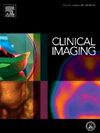Clinical experience on the limited role of ultrasound for breast cancer screening in BRCA1 and BRCA2 mutations carriers aged 30–39 years
IF 1.8
4区 医学
Q3 RADIOLOGY, NUCLEAR MEDICINE & MEDICAL IMAGING
引用次数: 0
Abstract
Purpose
In BRCA germline pathogenic sequence variants (PSV) carriers aged 30–39 years imaging is recommended at six-month intervals. The European society for medical oncology recommendation of the use of 6-monthly MRI six-monthly MRI screening is being considered at our institution, particularly for younger carriers under the age of 35, although it is not mandatory. If 6-monthly MRI is unavailable, annual MRI may be supplemented by ultrasound (with or without mammography). The aim of this study was to evaluate the utility of ultrasound screening added to mammography, as a 6-month supplement to annual MRI in BRCA PSV carriers aged 30–39 years.
Materials and methods
This IRB approved retrospective study included BRCA PSV carriers aged 30–39 years, who underwent breast cancer screening at our institution between January 2015 and March 2023. Participants were divided into two groups, those who had supplemental whole-breast US and mammography at six months and underwent screening before March 2019, and those who had only mammography without supplemental US and enrolled in screening after March 2019. Patient characteristics, cancer detection rates and cancer characteristics were compared between the two groups.
Results
Overall, 200 asymptomatic BRCA1/2 PSV carriers undergoing screening in our institution were included in the study. Mean age was 35.7 ± 3.5 years, and mean follow-up time was 37.4 ± 38.0 months. There were 118 (59 %) women screened with supplemental US, and 82 (41 %) women without. Eight cancers were diagnosed during the study period, four in women with supplemental US and four in women without. The sensitivity of whole-breast screening US was 25 % (1/4), specificity 85.7 % (222/259), PPV 2.6 % (1/38), and NPV 98.7 % (222/225). Of the four cancers detected in women screened with supplemental US, one was diagnosed by whole-breast US, two by MRI, and one by mammography. Of eight cancers included in this study, two were not detectable by targeted second-look US. All eight cancers were detectable by MRI.
Conclusion
The addition of whole-breast ultrasound to mammography and MRI screening in BRCA PSV carriers aged 30–39 years offered limited incremental benefit. MRI with 6 months supplemental mammography without US detected all cancer cases.
关于超声波在 30-39 岁 BRCA1 和 BRCA2 基因突变携带者乳腺癌筛查中的有限作用的临床经验。
目的:对于 30-39 岁的 BRCA 基因致病序列变异(PSV)携带者,建议每隔 6 个月进行一次成像检查。欧洲肿瘤内科学会(European Society for Medical Oncology)建议每 6 个月进行一次核磁共振成像(MRI)筛查,本机构正在考虑每 6 个月进行一次核磁共振成像筛查,尤其是针对 35 岁以下的年轻携带者,尽管这并非强制性规定。如果无法进行每 6 个月一次的磁共振成像筛查,则可以每年进行一次磁共振成像筛查,并辅以超声波检查(可进行或不进行乳腺 X 射线检查)。本研究的目的是评估在乳腺 X 光检查的基础上进行超声波筛查的效用,作为对 30-39 岁 BRCA PSV 携带者每年进行一次核磁共振成像检查的 6 个月补充:这项经 IRB 批准的回顾性研究纳入了 2015 年 1 月至 2023 年 3 月期间在我院接受乳腺癌筛查的 30-39 岁 BRCA PSV 携带者。参与者被分为两组,一组是在 6 个月时补充全乳房 US 和乳房 X 光检查并在 2019 年 3 月前接受筛查的患者,另一组是仅接受乳房 X 光检查而未补充 US 并在 2019 年 3 月后参加筛查的患者。对两组患者的特征、癌症检出率和癌症特征进行了比较:共有 200 名无症状的 BRCA1/2 PSV 携带者在我院接受筛查。平均年龄为(35.7 ± 3.5)岁,平均随访时间为(37.4 ± 38.0)个月。118名(59%)妇女接受了补充US筛查,82名(41%)妇女未接受筛查。研究期间确诊了 8 例癌症,其中 4 例接受了辅助 US 检查,4 例未接受辅助 US 检查。全乳腺 US 筛选的灵敏度为 25%(1/4),特异性为 85.7%(222/259),PPV 为 2.6%(1/38),NPV 为 98.7%(222/225)。在通过补充性 US 筛查的妇女中发现的四种癌症中,一种是通过全乳腺 US 诊断的,两种是通过 MRI 诊断的,一种是通过乳腺 X 光检查诊断的。在这项研究中发现的八种癌症中,有两种无法通过有针对性的二次乳腺 US 检测出来。结论:结论:对于 30-39 岁的 BRCA PSV 携带者,在乳房 X 光检查和核磁共振成像筛查的基础上增加全乳房超声检查,其增量效益有限。核磁共振成像与6个月的乳腺X光补充检查(无 US)可检测出所有癌症病例。
本文章由计算机程序翻译,如有差异,请以英文原文为准。
求助全文
约1分钟内获得全文
求助全文
来源期刊

Clinical Imaging
医学-核医学
CiteScore
4.60
自引率
0.00%
发文量
265
审稿时长
35 days
期刊介绍:
The mission of Clinical Imaging is to publish, in a timely manner, the very best radiology research from the United States and around the world with special attention to the impact of medical imaging on patient care. The journal''s publications cover all imaging modalities, radiology issues related to patients, policy and practice improvements, and clinically-oriented imaging physics and informatics. The journal is a valuable resource for practicing radiologists, radiologists-in-training and other clinicians with an interest in imaging. Papers are carefully peer-reviewed and selected by our experienced subject editors who are leading experts spanning the range of imaging sub-specialties, which include:
-Body Imaging-
Breast Imaging-
Cardiothoracic Imaging-
Imaging Physics and Informatics-
Molecular Imaging and Nuclear Medicine-
Musculoskeletal and Emergency Imaging-
Neuroradiology-
Practice, Policy & Education-
Pediatric Imaging-
Vascular and Interventional Radiology
 求助内容:
求助内容: 应助结果提醒方式:
应助结果提醒方式:


